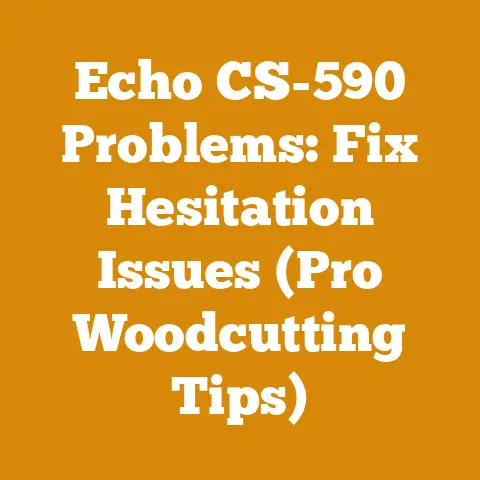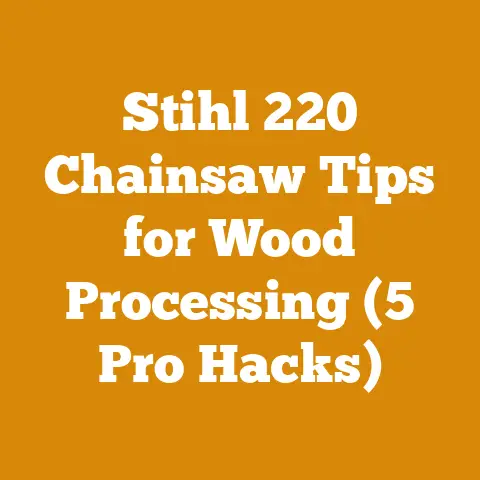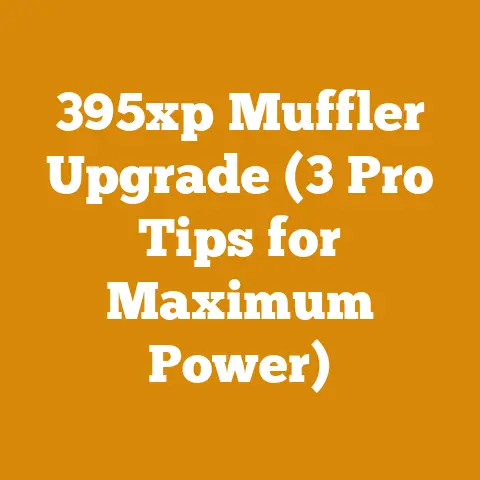How Much to Grind Stumps (5 Pro Tips for Accurate Pricing)
Let’s dive into the nitty-gritty of stump grinding pricing. It’s a job that seems straightforward, but believe me, after years of doing this, I’ve learned it’s an art and a science. One thing to consider right off the bat is wear and tear. Stump grinding is brutal on equipment. Rocks, hidden metal, and the sheer force needed to pulverize wood take their toll. Ignoring this crucial factor when pricing can quickly eat into your profits. So, let’s get this right!
How Much to Grind Stumps: 5 Pro Tips for Accurate Pricing
Stump grinding… it’s a task often overlooked, but essential for a clean and usable landscape. Whether you’re a homeowner reclaiming your yard, a landscaper preparing for a new project, or a small contractor trying to make a living, accurately pricing stump grinding is critical. Too low, and you’re working for peanuts (and wearing out your equipment!). Too high, and you’ll lose the job.
Over the years, I’ve seen countless people underestimate the complexities involved in stump grinding. They think it’s just about running a machine over a piece of wood. But it’s so much more. It’s about understanding wood density, root systems, soil conditions, machine capabilities, and, most importantly, safety. It’s also about knowing your worth and charging a fair price for your expertise and equipment.
These tips are based on my experience running a small tree service, including stump grinding, for over a decade. I’ve learned from mistakes, successes, and countless hours spent covered in wood chips. I’ve also incorporated data from industry surveys and pricing guides to give you a well-rounded perspective.
1. Accurately Assess Stump Size and Accessibility
The size of the stump is the most obvious factor in determining price, but it’s not as simple as measuring the diameter at ground level. You need to consider several things:
- Diameter at the widest point: This is your starting point. Use a measuring tape to get an accurate reading. Don’t guess!
- Height above ground: A taller stump will take longer to grind. Anything above 6 inches adds to the complexity.
- Root flare: The root flare is the area where the roots emerge from the trunk. This area can be significantly wider than the main stump diameter and often contains dense, hard wood. You’ll need to grind this area down as well.
- Depth below ground: This is the most challenging factor to estimate, but crucial. Most customers want the stump ground down to at least 6-12 inches below ground level to allow for replanting or landscaping. Probing the soil around the stump with a shovel or metal rod can give you an idea of the root system’s depth.
Accessibility is Key:
Getting the stump grinder to the stump is often half the battle. Consider these factors:
- Gate width: Can your machine fit through the gate? If not, you may need to use a smaller machine or remove a section of the fence, which adds time and labor.
- Terrain: Is the ground level, sloped, or uneven? Steep slopes or rough terrain can make it difficult to maneuver the grinder and increase the risk of accidents.
- Obstacles: Are there fences, buildings, utilities, or other obstacles around the stump? These can restrict your movement and require extra care.
- Underground utilities: Always call 811 (in the US) or your local equivalent to have underground utilities marked before you start grinding. Hitting a gas line or electrical cable can be disastrous.
Pricing Based on Size and Accessibility:
- Per-inch pricing: This is the most common method. I typically charge between $3 and $8 per inch of diameter, depending on the factors mentioned above. For example, a 20-inch stump might cost between $60 and $160.
- Hourly rate: This is best for jobs with multiple small stumps or stumps in difficult locations. My hourly rate is usually between $75 and $150 per hour, including travel time.
- Minimum charge: I always have a minimum charge of around $100 to cover my travel time and setup costs.
Case Study:
I once had a customer with a large oak stump, about 36 inches in diameter. The stump itself wasn’t too difficult, but it was located in the backyard, accessible only through a narrow gate. I had to use my smaller, walk-behind grinder, which took significantly longer. I quoted the customer $250 based on the difficulty of access, even though the per-inch price would have been lower. They understood and were happy to pay for the convenience.
Original Insight:
Don’t be afraid to walk away from a job if the accessibility is too challenging or dangerous. Your safety and the integrity of your equipment are more important than any single job.
2. Factor in Wood Type and Condition
Not all wood is created equal. Some wood is soft and easy to grind, while others are dense and resistant. The condition of the wood also plays a significant role.
- Hardwoods vs. Softwoods: Hardwoods like oak, maple, and hickory are much denser than softwoods like pine, fir, and cedar. Hardwoods will take longer to grind and wear down your teeth faster.
- Green Wood vs. Seasoned Wood: Green wood, freshly cut, is much easier to grind than seasoned wood, which has dried out and hardened.
- Rotten Wood: Rotten wood might seem easy to grind, but it can be problematic. It tends to crumble and throw debris, making it difficult to control. It can also be more abrasive due to the presence of soil and grit.
Identifying Wood Types:
- Bark: The bark can often give you a clue about the wood type. Oak bark is rough and furrowed, while maple bark is smoother.
- Leaves: If there are any leaves remaining, they can help you identify the tree.
- Grain: The grain pattern of the wood can also be helpful. Hardwoods typically have tighter, more intricate grain patterns than softwoods.
Adjusting Prices Based on Wood Type and Condition:
- Hardwoods: Add 20-50% to your base price for hardwoods.
- Seasoned Wood: Add 10-20% to your base price for seasoned wood.
- Rotten Wood: Price this on an hourly basis to account for the unpredictable nature of the job.
Personalized Story:
I once underestimated the difficulty of grinding a large, seasoned maple stump. The wood was incredibly hard, and I went through several teeth on my grinder. I ended up losing money on that job. Now, I always carefully assess the wood type and condition before providing a quote.
Data and Original Insight:
According to industry surveys, the average lifespan of stump grinder teeth is reduced by 30-40% when grinding hardwoods compared to softwoods. This increased wear and tear should be reflected in your pricing. Also, consider the angle of the grain. Wood that was cut at an angle or has twisted grain can be especially tough.
3. Account for Travel Time and Disposal Costs
Travel time is a significant expense, especially if you’re traveling long distances. Don’t forget to factor in the cost of fuel, vehicle maintenance, and your time.
- Calculate Travel Time: Use a GPS or online mapping tool to estimate the travel time to the job site and back.
- Fuel Costs: Track your fuel consumption and the current price of fuel to determine your fuel costs per mile.
- Vehicle Maintenance: Allocate a portion of your vehicle maintenance costs to each job. This includes oil changes, tire replacements, and other repairs.
- Time is Money: Factor in your hourly rate for travel time. Even if you’re not actively working, your time is valuable.
Disposal Costs:
Stump grinding generates a significant amount of wood chips. You need to factor in the cost of disposing of these chips.
- On-site Disposal: If the customer wants to keep the wood chips, you can spread them around the yard or use them as mulch. This is the cheapest option.
- Off-site Disposal: If the customer doesn’t want the wood chips, you’ll need to haul them away and dispose of them at a landfill or composting facility. This can be expensive, especially if you have to pay tipping fees.
- Transportation: You’ll need a truck and trailer to haul away the wood chips. Factor in the cost of renting or owning this equipment.
Pricing Based on Travel and Disposal:
- Travel Charge: I typically charge a flat travel fee of $25-$50, depending on the distance.
- Disposal Fee: If I have to haul away the wood chips, I charge an additional fee of $50-$150, depending on the volume of chips and the disposal costs.
Example:
A customer wants a stump ground that is 30 miles away. The job will generate about 2 cubic yards of wood chips.
- Travel Time: 1 hour round trip
- Fuel Costs: $10
- Travel Charge: $40 (based on $40/hr rate)
- Disposal Fee: $100 (including tipping fees)
Total Travel and Disposal Costs: $150
Strategic Advantage:
Offer customers the option of keeping the wood chips to reduce their overall cost. This can be a selling point that sets you apart from your competitors. Plus, wood chips make excellent mulch!
4. Factor in Equipment Costs and Maintenance
Stump grinders are expensive machines, and they require regular maintenance to keep them running smoothly. You need to factor in these costs when pricing your jobs.
- Purchase Price: Divide the purchase price of your grinder by its expected lifespan to determine your annual depreciation cost.
- Maintenance Costs: Track your maintenance costs, including oil changes, tooth replacements, belt replacements, and other repairs.
- Insurance: You’ll need liability insurance to protect yourself from accidents and injuries.
- Storage: If you don’t have a garage or shed, you’ll need to pay for storage space.
Tool Specifications:
- Stump Grinder: I primarily use a Vermeer SC362 stump grinder. It’s a powerful and reliable machine that can handle most stumps. It has a 35-horsepower engine and a 16-inch cutting wheel. Tooth replacement costs average about $5 per tooth.
- Chainsaw: I use a Stihl MS 261 C-M chainsaw to cut away any large roots that are blocking the grinder. It has a 18-inch bar and a powerful engine.
- Safety Gear: I always wear safety glasses, hearing protection, and steel-toed boots when operating the grinder.
Pricing Based on Equipment Costs:
- Hourly Rate: Factor in the hourly cost of operating your equipment, including depreciation, maintenance, insurance, and fuel.
- Markup: Add a markup to your costs to cover your profit margin. A markup of 20-30% is typical.
Example:
- Stump Grinder Purchase Price: $15,000
- Expected Lifespan: 5 years
- Annual Depreciation: $3,000
- Annual Maintenance Costs: $500
- Annual Insurance Costs: $500
- Total Annual Equipment Costs: $4,000
- Hourly Equipment Costs: $20 (assuming 200 hours of use per year)
Original Insight:
Don’t skimp on maintenance. A well-maintained grinder will last longer and perform better. Regular maintenance can also prevent costly breakdowns that can put you out of business.
5. Understand Your Local Market and Competition
The price you can charge for stump grinding will depend on your local market and the competition. Research what other companies in your area are charging and adjust your prices accordingly.
- Online Research: Search online for stump grinding services in your area and compare their prices.
- Phone Calls: Call other companies and ask for quotes.
- Networking: Talk to other landscapers and tree service professionals to get an idea of the going rate.
Pricing Strategies:
- Competitive Pricing: Match your prices to your competitors’ prices.
- Value Pricing: Charge slightly higher prices than your competitors, but offer superior service or value.
- Discount Pricing: Offer lower prices than your competitors to attract customers.
Case Study:
When I first started my business, I was undercharging for my services. I was afraid to lose customers if I charged too much. However, I soon realized that I was working too hard for too little money. I did some research and found that my competitors were charging significantly more than I was. I raised my prices and didn’t lose any customers. In fact, I gained more customers because they perceived my services as being higher quality.
Technical Details:
- Moisture Content Targets: When disposing of wood chips, landfills typically have moisture content restrictions. Make sure the wood chips are dry enough to meet these requirements.
- Drying Times: Wood chips can take several weeks or months to dry, depending on the weather conditions. Spread the chips out in a thin layer to speed up the drying process.
Final Thoughts and Next Steps:
Accurately pricing stump grinding is essential for running a profitable business. By considering stump size, accessibility, wood type, travel time, disposal costs, equipment costs, and your local market, you can develop a pricing strategy that works for you.
Next Steps:
- Assess Your Equipment: Make sure your stump grinder is in good working order.
- Research Your Market: Find out what other companies in your area are charging.
- Develop a Pricing Strategy: Create a pricing sheet that includes your base prices, travel charges, disposal fees, and other costs.
- Practice Your Estimating Skills: Practice estimating the cost of stump grinding jobs by visiting potential customers and providing quotes.
- Track Your Costs: Keep track of your expenses to ensure that you’re making a profit.
Stump grinding can be a rewarding and profitable business. With the right knowledge and skills, you can provide a valuable service to your community and earn a good living. Remember safety is paramount. Always wear appropriate safety gear and follow safe operating procedures. Good luck, and happy grinding!






